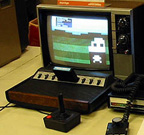
« PREVIOUS ENTRY
Did the Old Masters trace their most famous paintings?

Check it out. Programmer Paul Slocum is working on a Homestar Runner game — for the Atari 2600! You can check out the details here, but the project makes a weird sort of sense. After all, Homestar Runner is a web cartoon designed in Flash, a vector-based animation engine — which gives it a sort of ontological provenance in the world of computerized simulations. Plus, Homestar Runner is intentionally low-fi, making it exquisitely translatable to the chunky graphics of the Atari 2600. Porting web ‘toons to early gaming platforms: I think this guy has discovered a sort of Rosetta Stone for digital content!
Actually, Slocum is one of the most prominent artists in a strange subculture — programmers who create new games for the Atari 2600, and sell them in old-school cartridge format. There’s a host of these games for sale at Atari Age, including Solcum’s earlier masterpiece, Marble Craze. In that game, you use both paddle-wheels at once — giving you an extraordinarily high degree of control over a marble, as you attempt to wend it through a series of mazes and puzzles. Atari Age reviewers went faintly berserk with praise for the game, which also makes sense: By abjuring high-end graphics, Slocum imposed a sort of sonnet-like restriction upon his design that forced him to focus on the nature of play. I actually think every game designer on the planet should be required to produce a fun, addictive game for the Atari 2600 before they’re allowed to produce a game for the Xbox, Playstation or computer. That way, they’d actually learn how to come up with things that make for good play, not merely good eye candy.
Actually, some of these homebrew games look pretty cool. Consider the description for “SCSIcide”:
If you’re a fan of fast-paced paddle games like Kaboom!, then you’ll love SCSIcide. In SCSIcide you play the role of a hard drive read head. As the different colored bits scroll by on the hard drive platter, you need to quickly read them in the correct order before you suffer a buffer underflow. As you complete each level, the data scrolls by more and more quickly! How far can you go?
This reminds me of a neat argument about games I once read. Back in the late 80s, the American Museum of the Moving Image held an exhibit devoted to early-80s video games. In an essay commissioned for the show, the author (sorry, I can’t remember who it was) argued that because early video games were a) severely limited by memory and graphics, and b) programmed by geeks who were fascinated by the internal mechanics of chips and code, the games were essentially metaphoric projections of the internal life of computers. And it’s actually kind of true. Consider the language of early games: They were all about navigating mazes (file systems), figuring out how to open doors (files and drive sectors), “saving” things, etc. As I later joked, “video games are what computers think about when we’re not using them.” So this SCSIcide game forms a neatly recursive loop. It’s a game that is based on the dynamics of a modern computer drive, yet played on game system so old that it formed the inspiration for millions of kid geeks to get into programming.
I'm Clive Thompson, the author of Smarter Than You Think: How Technology is Changing Our Minds for the Better (Penguin Press). You can order the book now at Amazon, Barnes and Noble, Powells, Indiebound, or through your local bookstore! I'm also a contributing writer for the New York Times Magazine and a columnist for Wired magazine. Email is here or ping me via the antiquated form of AOL IM (pomeranian99).

ECHO
Erik Weissengruber
Vespaboy
Terri Senft
Tom Igoe
El Rey Del Art
Morgan Noel
Maura Johnston
Cori Eckert
Heather Gold
Andrew Hearst
Chris Allbritton
Bret Dawson
Michele Tepper
Sharyn November
Gail Jaitin
Barnaby Marshall
Frankly, I'd Rather Not
The Shifted Librarian
Ryan Bigge
Nick Denton
Howard Sherman's Nuggets
Serial Deviant
Ellen McDermott
Jeff Liu
Marc Kelsey
Chris Shieh
Iron Monkey
Diversions
Rob Toole
Donut Rock City
Ross Judson
Idle Words
J-Walk Blog
The Antic Muse
Tribblescape
Little Things
Jeff Heer
Abstract Dynamics
Snark Market
Plastic Bag
Sensory Impact
Incoming Signals
MemeFirst
MemoryCard
Majikthise
Ludonauts
Boing Boing
Slashdot
Atrios
Smart Mobs
Plastic
Ludology.org
The Feature
Gizmodo
game girl
Mindjack
Techdirt Wireless News
Corante Gaming blog
Corante Social Software blog
ECHO
SciTech Daily
Arts and Letters Daily
Textually.org
BlogPulse
Robots.net
Alan Reiter's Wireless Data Weblog
Brad DeLong
Viral Marketing Blog
Gameblogs
Slashdot Games